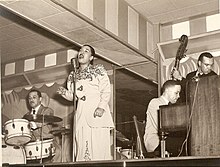Billie Holiday
[13] Holiday's autobiography, Lady Sings the Blues, published in 1956, is inconsistent regarding details of her early life, but much was confirmed by Stuart Nicholson in his 1995 biography of the singer.
She found a job running errands in a brothel,[19] and she scrubbed marble steps as well as kitchen and bathroom floors of neighborhood homes.
In particular, Holiday cited "West End Blues" as an intriguing influence, pointing specifically to the scat section duet with the clarinet as her favorite part.
As her reputation grew, she played in many clubs, including the Mexico's and the Alhambra Bar and Grill, where she met Charles Linton, a vocalist who later worked with Chick Webb.
[28] In 1935, Holiday had a small role as a woman abused by her lover in Duke Ellington's musical short film Symphony in Black: A Rhapsody of Negro Life.
[29] In 1935, Holiday was signed to Brunswick by John Hammond to record pop tunes with pianist Teddy Wilson in the swing style for the growing jukebox trade.
Her tunes included "I Must Have That Man", "Travelin' All Alone", "I Can't Get Started", and "Summertime", a hit for Holiday in 1936, originating in George Gershwin's Porgy and Bess the year before.
On January 16, 1938, the same day that Benny Goodman performed his legendary Carnegie Hall jazz concert, the Basie and Webb bands had a battle at the Savoy Ballroom.
Holiday spoke about the incident weeks later, saying, "I was never allowed to visit the bar or the dining room as did other members of the band ... [and] I was made to leave and enter through the kitchen."
By the late 1930s, Holiday had toured with Count Basie and Artie Shaw, scored a string of radio and retail hits with Teddy Wilson, and became an established artist in the recording industry.
[45] Holiday was in the middle of recording for Columbia in the late 1930s when she was introduced to "Strange Fruit", a song by Abel Meeropol based on his poem about lynching.
The Commodore release did not get any airplay, but the controversial song sold well, though Gabler attributed that mostly to the record's other side, "Fine and Mellow", which was a jukebox hit.
The success and distribution of the song made Holiday a staple in the pop community, leading to solo concerts, rare for jazz singers in the late 1940s.
Plagued by racism and McCarthyism, producer Jules Levey and script writer Herbert Biberman were pressed to lessen Holiday's and Armstrong's roles to avoid the impression that black people created jazz.
The drug possession conviction caused her to lose her New York City Cabaret Card, preventing her working anywhere that sold alcohol; thereafter, she performed in concert venues and theaters.
The Swedish impresario Nils Hellstrom initiated the "Jazz Club U.S.A." (after the Leonard Feather radio show) tour starting in Stockholm in January 1954 and then Germany, Netherlands, Paris and Switzerland.
[93] In his 2015 study, Billie Holiday: The Musician and the Myth, John Szwed argued that Lady Sings the Blues is a generally accurate account of her life, but that co-writer Dufty was forced to water down or suppress material by the threat of legal action.
The album featured four new tracks, "Lady Sings the Blues", "Too Marvelous for Words", "Willow Weep for Me", and "I Thought About You", and eight new recordings of her biggest hits to date.
"Strange Fruit" and "God Bless the Child" were called classics, and "Good Morning Heartache", another reissued track on the LP, was also noted favorably.
"[99]The critic Nat Hentoff of DownBeat magazine, who attended the Carnegie Hall concert, wrote the remainder of the sleeve notes on the 1961 album.
The beat flowed in her uniquely sinuous, supple way of moving the story along; the words became her own experiences; and coursing through it all was Lady's sound – a texture simultaneously steel-edged and yet soft inside; a voice that was almost unbearably wise in disillusion and yet still childlike, again at the centre.
Also in 1957, she sang as a headliner with Dinah Washington and others in Jazz Under the Stars, a summer concert series that took place at the Wollman Memorial Theater in New York City's Central Park.
[102] They were separated at the time of her death, but McKay had plans to start a chain of Billie Holiday vocal studios, on the model of the Arthur Murray dance schools.
Her manager, Joe Glaser, jazz critic Leonard Feather, photojournalist Allan Morrison, and the singer's own friends all tried in vain to persuade her to go to a hospital.
The likelihood exists that among the last thoughts of this cynical, sentimental, profane, generous and greatly talented woman of 44 was the belief that she was to be arraigned the following morning.
In July 2022, after finding transcripts of Max Jones's tape, Williams wrote an article for The Syncopated Times about Hall's secret visit.
Holiday stated that she had always wanted her voice to sound like an instrument, and some of her influences included trumpeter Louis Armstrong and singer Bessie Smith.
[117] Holiday's last major recording, a 1958 album titled Lady in Satin, features the backing of a 40-piece orchestra conducted and arranged by Ray Ellis.
[126] The biographical film Lady Sings the Blues, loosely based on Holiday's autobiography, was released in 1972 and was nominated for five Academy Awards, including Best Actress for Diana Ross.
Director Lee Daniels saw how Holiday was portrayed in the 1972 biopic, and wanted to show her legacy as "a civil rights leader [ ... ] not just a drug addict or a jazz singer".







